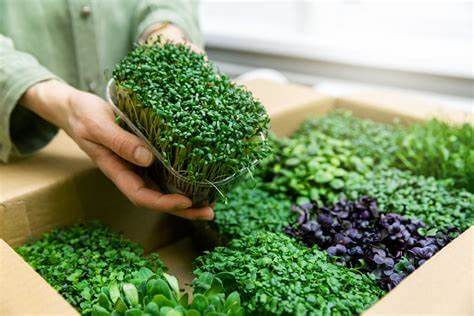
Mighty Microgreens: Unveiling the Health Wonders of Tiny Greens
Microgreens are young vegetable greens that are approximately 1–3 inches tall. They are the intermediate stage between sprouts and baby leaf vegetables. Typically, they are harvested within 7-21 days after germination, once the plant’s first true leaves have emerged. Microgreens boast a concentrated nutrient profile and are rich in vitamins, minerals, and antioxidants.
Varieties of Microgreens: There is a wide variety of microgreens available, each with its unique flavor and nutritional benefits. Some popular types include:
- Arugula: Peppery, rich in vitamin K and folate.
- Kale: Slightly sweet, a good source of vitamins A, C, and K.
- Radish: Spicy, contains vitamins A, B, C, E, and K.
- Pea Shoots: Sweet, high in vitamin C and fiber.
- Sunflower: Nutty flavor, packed with protein and essential fatty acids.
- Broccoli: Mild flavor, known for its cancer-preventing compounds.
Differences from Sprouts and Baby Greens:
- Sprouts are germinated seeds that are eaten root, seed, and shoot. They are typically grown in water and harvested within 2-7 days before true leaves develop.
- Microgreens, on the other hand, are grown in soil or soil substitutes, require sunlight, and are harvested after the first true leaves appear.
- Baby greens are harvested at a later stage than microgreens, usually after 21 days, and have a larger size and more developed flavor profile.
Microgreens are distinct from sprouts in that they require a growing medium and light to produce chlorophyll and develop color and flavor. Unlike baby greens, they are much smaller and tender, often used as a garnish or added to salads for a nutritional boost.
Microgreens are not only a delightful addition to your plate but also bring a host of health benefits, many of which are supported by research. Here’s a summary of the key health benefits backed by scientific studies:
- Nutrient-Rich: Research indicates that microgreens may contain 4 to 40 times the nutrients of mature plant leaves, making them a concentrated source of vitamins, minerals, and antioxidants.
- Blood Sugar Regulation: Studies on animals suggest that broccoli microgreens can improve insulin resistance, helping sugar move from the blood into cells. Fenugreek microgreens might also enhance cellular sugar uptake by 25% to 44%, which can be beneficial for managing Type 2 diabetes.
- Cognitive Health: Polyphenols, which are abundant in microgreens, have been linked to improved cognitive function and may even help prevent or delay the onset of neurodegenerative diseases like Alzheimer’s disease.
-
Heart Health: The polyphenols in microgreens are associated with a lower risk of heart disease. They act as antioxidants, which can prevent cell damage and contribute to cardiovascular health.
-
Antioxidant Properties: Microgreens are high in antioxidants that protect the body from free radicals, reducing the risk of various diseases.
These findings underscore the potential of microgreens as a superfood that can contribute significantly to a healthy diet. Microgreens are more than just a culinary trend; they are a powerhouse of nutrients that offer significant health benefits. By making microgreens a regular part of your diet, you can enjoy their fresh flavor while boosting your health in a big way.
